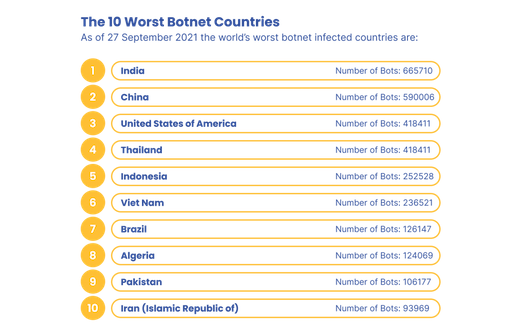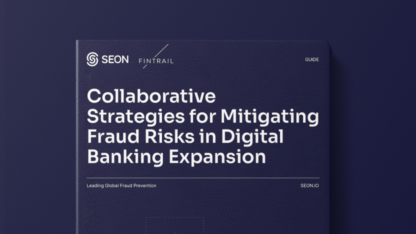List of Bot Detection Software & Tools
- SEON: Real-Time Risk Scoring and Unique Data Enrichment
- DataDome: Specialized Store and Classifieds Bot Protection
- Arkose Labs: 100% Guaranteed Bot Attack Detection
- Cloudflare: Tools for Faster, Safer Websites
- ClickGUARD: Protecting PPC Google Ads Campaigns
- Radware Bot Manager: Protect from All Automated Threats
- Reblaze: All-in-One Private Cloud Security
- BioCatch: Behavioral Insights to Protect Accounts
- Outseer: Making Waves in the Fintech World
- CHEQ: Blocks Invalid Traffic and Botnets
What Is a Bot Detection and Mitigation Software?
Bot detection and mitigation software allow you to let through legitimate traffic and identify and/or block bots. By extracting data relating to the connection type or device used, you can understand whether a visitor is a human or a bot.
Regardless of your industry, it’s important to understand who your web visitors are. Bots, which are essentially scripts, or computer programs, aren’t always nefarious but are still worth investigating, as they can be closely connected to cybercrime and online fraud.
Top Features of Bot Detection and Mitigation Software
Bot detection service vendors deliver techniques that vary, but there are a few recurring features, such as:
- IP lookup and analysis: Understanding the type of online connection used by your website visitors can filter out bots and let through humans.
- Device fingerprinting: Analyzing the combination of software and hardware used to connect to your site can point to suspicious activity – especially for botnets using the same devices or spoofing tools.
- Velocity risk rules: In bot detection, velocity rules allow you to learn how often someone does something online, providing insight into their behavior and motivation. This helps you identify bots that perform the same action or sequences of actions repeatedly.
- Real-time alerts: You may have to deal with spikes in traffic that could point to a botnet attack. It’s important to safeguard your website by creating fraud alerts for that purpose.
10 Bot Detection Software Solutions
SEON
Real-Time Risk Scoring and Data Enrichment
SEON is, first and foremost, fraud detection software, but its features also work perfectly for bot detection. This is all thanks to its real-time monitoring, which allows risk teams to get a better live understanding of their website traffic, as well as data enrichment and powerful risk scoring.
Most of the heavy lifting for bot detection is done via IP analysis, velocity checks, and device fingerprinting.
Pros
- Complete fraud prevention solution
- Digital footprint analysis
- Flexible and modular
Cons
- Not cybersecurity-specific
SEON Pricing
- Starts at $599. Free version available with limited API calls.
Choose SEON If
- You want to combine bot detection with fraud prevention and risk management without affecting the user experience (UX).
IP analysis, velocity checks, and device fingerprinting allow you to understand how users connect to your site and to get an idea of their online behavior. This provides answers to questions such as:
- Has this user performed the same task repeatedly?
- Have they previously appeared with a similar browser and/or device configuration?
- Is there any suspicious data (blacklisted IP addresses, Tor, etc.)?
- Can we spot similar configurations with other users (potential botnet)?
- Does the user appear to be using a headless version of Chrome?
- Are they using an emulator such as Selenium?
With clear risk scores and dynamic friction, you get complete bot mitigation features to allow, decline or review bot traffic without impacting the experience of legitimate users.
SEON Pros
- Complete fraud prevention solution: SEON does not just offer a bot detection service but also flags and prevents multi-accounting, chargeback fraud, and other malicious attacks.
- Digital footprint analysis: Check signals from 90+ social media networks to confirm whether you’re dealing with real users or not.
- Flexible and modular: Few other providers on the market offer tools that can be adapted to so many verticals, from iGaming poker bot detection to account takeover protection.
SEON Cons
- Not cybersecurity-specific: If you require DDoS protection, for instance, you’ll need to look elsewhere.

Partner with SEON to reduce fraud rates in your business with real time data enrichment, unique insights, machine learning and advanced APIs.
Speak with an Expert
DataDome
Online Store and Classifieds Bot Protection
DataDome, which calls itself the #1 SaaS bot protection solution for ecommerce and classified ads businesses, offers dashboards and real-time alerting to keep an eye on your traffic.
You can adjust and filter actions to fight against bot activity manually. It even allows you to segment bots into good bots, bad bots, and monetization bots. In the bad bots section, the software will prevent DDoS attacks, SQL injections, and scraping.
DataDome is compatible with every web infrastructure technology, multi-cloud, and even multi content delivery network (CDN) setups. At the time of writing, the company protects 10,000+ ecommerce and classified domains worldwide, including TripAdvisor, the New York Times, and ZocDoc.
Pros
- Multiple bot attack prevention
- Great for classified ads
Cons
- Pricey
DataDome Pricing
- Business is $3,490 a month to protect websites. Corporate is $6,190 a month for 200M requests per month and lets you deploy DataDome on websites, mobile apps, and APIs. Enterprise is $8,190 a month for 300M requests.
Choose DataDome If
- You need to protect your classifieds site or an online store that allows reviews and comments.
DataDome Pros
- Multiple bot attack prevention: DataDome protects against a pretty exhaustive list of potential bot attacks.
- Great for classified ads: Few other bot detection software providers specialize in helping reduce fraudulent postings, reviews, and feedback.
DataDome Cons
- Pricey: Unless you’re an enterprise client, DataDome’s pricing is not really at the affordable end of the spectrum.
Arkose Labs
100% Guaranteed Bot Attack Detection
When it comes to bot detection software, few companies can claim to be as confident as Arkose Labs. This bot detection service vendor even includes a commercial service level agreement (SLA) guarantee against bot attacks as part of its service agreement.
The company says it can identify, block and monitor high-volume attacks, low and slow attacks, and even hybrid attacks that combine bots and human fraud farms to bypass your security checks. To do so, it doesn’t rely on static rules or risk scoring but on real-time intelligence, rich analytics, and step-up challenges to eliminate the return on investment (ROI) of bot fraud.
Pros
- Unique detection method
- 100% guarantee SLA
Cons
- Incentive to block legitimate users
Arkose Labs Pricing
- Available from the sales team.
Choose Arkose Labs If
- You want to test the limits of its impressive 100% bot detection SLA.
Arkose Labs Pros
- Unique detection method: Arkose Labs doesn’t rely on risk scoring or filtering rules.
- 100% guarantee SLA: The company has such confidence in its ability to mitigate bot traffic that it’s part of the service agreement.
Arkose Labs Cons
- Incentive to block legitimate users: The downside of a 100% guarantee is that it can make Arkose Labs overly zealous, potentially resulting in false positives.
Cloudflare
Tools for Faster, Safer Websites
As one of the biggest domain name systems (DNS) and CDNs operating on the internet, Cloudflare needs little introduction these days.
What not many people realize, however, is that the service protects internet properties from malicious activity such as malicious bots and DDoS attacks.
If you’re already using Cloudflare or are launching a new venture, it’s a very attractive proposition, as you can get affordable bot mitigation along with all the tools needed to make your website faster and more efficient.
The company provides both security and performance to over 25 million internet sites worldwide. Best of all, you can benefit from its DDoS attack mitigation tool as part of its free offer, which also includes DNS, CDN, and free automated SSL certificates.
Pros
- Full CDN and DNS solution
- Affordable
Cons
- Not fully featured
Cloudflare Pricing
- Cloudflare offers many of its services as modules. The bot mitigation and DDoS protection module has a generous free plan, along with a Pro and Business plan for $20 and $200 per month, respectively. Enterprise-level businesses should negotiate a contract with Cloudflare’s sales team.
Choose Cloudflare If
- You need affordable, basic bot detection software along with a CDN.
Cloudflare Pros
- Full CDN and DNS solution: The bot protection is only an extra feature with Cloudflare. Its key use case is to deliver content faster to your users.
- Affordable: Not only is there a free plan, but the paid plans are competitively priced.
Cloudflare Cons
- Not fully featured: You wouldn’t be able to count on Cloudflare to protect your iGaming company or online store from fake reviews, for instance.
ClickGUARD
Protecting PPC Google Ads Campaigns
When it comes to online advertising fraud, bots are one of the biggest headaches for marketers. How can they ensure they get the right metrics, discounting abusive, disruptive, fraudulent, or wasteful clicks?
The answer comes courtesy of ClickGUARD, a solution designed to identify and block all types of unwanted clicks on your Google Ads campaigns. It’s ideal both for advertisers and agencies that need to make the best out of their Google Ads budgets or scale their services and tools for clients.
It might not be the most versatile bot detection software, but ClickGUARD integrates seamlessly with other marketing tools such as ClickFunnels, Hubspot, and even Shopify, Weebly, and Wix, so you can ensure you get the most from your marketing dollars.
Pros
- Tailored for Google Ads
Cons
- Only works for one kind of bot detection
ClickGUARD Pricing
- ClickGuard offers three-tiered pricing, with a 20% discount for annual billing. The Lite plan costs $74 a month for a single website and up to $5K ad spend. Standard is $119 a month and starts at $10K ad spend for three websites. Pro costs $159 a month and lets you protect unlimited websites, starting at $10K ad spend.
Choose ClickGUARD If
- You want to get better ROI from your Google Ads campaigns.
ClickGUARD Pros
- Tailored for Google Ads: If your use case is reducing Google Ads bot traffic, you won’t find a better contender than ClickGUARD.
ClickGUARD Cons
- Only works for one kind of bot detection: DDoS protection, credential stuffing, or protection from other kinds of attacks are not available.
Radware Bot Manager
Protection from All Automated Threats
Radware offers a complete suite of protection products, including advanced multi-cloud application delivery, public cloud protection, and DDoS protection for data centers. It’s a cybersecurity company that also deals with malware protection and specific attacks on IT systems.
The company has a specific bot management solution, appropriately named Radware Bot Manager. It uses a detection engine that collects over 250 parameters to understand traffic and detect bots in real-time.
As such, it is designed to mitigate and prevent account takeover fraud, DDoS, API abuse, carding, scraping, ad fraud, and form spam. It is aimed at enterprise clients in ecommerce, media, fintech, and legal services.
Pros
- Real-time monitoring
- Integration with other Radware products
- Reliable and renowned
Cons
- Pricey
- Need to pay for other tools
Radware Pricing
- Radware comes with a free trial, but the pricing system is not listed on the Radware website.
Choose Radware Bot Manager If
- You are an enterprise client who already uses other Radware products for cybersecurity.
Radware Pros
- Real-time monitoring: Get alerts in real-time to manually review suspicious activity pointing to bot usage.
- Integration with other Radware products: Choosing the company’s Bot Manager makes sense if you’re already in the Radware ecosystem.
- Reliable and renowned: Radware was founded in 1997 and has a long list of trustworthy clients.
Radware Cons
- Pricey: Reviews posted online regularly point out that the pricing model is fairly expensive.
- Need to pay for other tools: Radware segments its products based on specific use cases, so if you need better DDoS protection, it will sell you an extra tool.
Reblaze
All-in-One Private Cloud Security
Reblaze offers bot control as one of its many features, which also include a Web Application Firewall (WAF), API protection, CDN and load balancing, and even real-time traffic control for web developers.
It is a technical tool for clients with complex cybersecurity needs. The way it works is by controlling traffic in the cloud and filtering it there before it reaches the protected network.
With a latency of ~0.5 ms, this product is a fast, effective way to control incoming web traffic before allowing legitimate users to access your site.
Pros
- Cloud-based protection solution
- Complete toolset
- Real-time monitoring
Cons
- User interface (UI)/user experience (UX)
- Expensive
Reblaze Pricing
- Reblaze offers a free trial, but you have to contact them to get a quote.
Choose Reblaze If
- You have complex security needs and require multiple protection tools to control your incoming web traffic.
Reblaze Pros
- Cloud-based protection solution: Reblaze creates a security layer between web traffic and your website to give you full control, doing it fast enough not to slow your performance.
- Complete toolset: You can mitigate bot traffic, DDoS attacks, and other nefarious traffic.
- Real-time monitoring: Reblaze allows you to manage your system and to see false positives or negatives in real-time, so that you can adjust your filtering rules expeditiously.
Reblaze Cons
- UI/UX: Reblaze is powerful, but learning how to get the most out of its features can be a steep learning curve.
- Expensive: As a complete cybersecurity solution, Reblaze isn’t affordable for small and medium businesses (SMBs).
BioCatch
Behavioral Insights to Protect Accounts
Founded by a former whitehat hacker in the Israeli military, Avi Turgeman, BioCatch boasts primary technology based on his experience with behavioral biometrics and cyberterrorism.
Since its founding in 2011, BioCatch’s client roster has expanded to include huge ecommerce companies like Barclays, Citigroup, Experian, and NatWest. The fraud solution product that BioCatch offers is weighted heavily towards catching automated users within a system by looking at their behavior during the customer journey.
The behavioral data that the program scans for signs of automation are broken into three sets: behavioral biometrics, cognitive analysis, and behavioral insights. Within these sets, the software is capable of measuring and drawing conclusions on incoming traffic by looking at things like swiping, vibrations, and press duration when connecting on a mobile device, as well as other human identifiers like typing cadence.
Pros
- Huge fraud identifier database
- Part of a full fraud prevention suite
Cons
- Focuses on enterprise-level businesses
BioCatch Pricing
- Focusing on enterprise-level businesses, BioCatch offers bespoke contract-based pricing models.
Choose BioCatch If
- You want to focus on behavioral tools rather than data enrichment to catch bots.
BioCatch Pros
- Huge fraud identifier database: Over 2,000 behavioral data points to analyze traffic for signs of botnets.
- Part of a full fraud prevention suite: You can stop bots, manage risk rules, identify threat vectors, and much more with BioCatch’s full suite of products.
BioCatch Cons
- Focuses on enterprise-level businesses: BioCatch focuses on fintech and banking and has a price point aimed at those verticals.
Outseer
Making Waves in the Fintech World
Outseer is a recent entry into the software-based fraud solution market, having recently spun off of its parent security firm, RSA. Through RSA’s longtime reputation as a security provider, Outseer has already claimed notable fintech clients like USAA, NewDay, and Fifth Third Bank despite only being a sovereign company since 2021.
The four main solutions that Outseer offers are aimed at emerging concerns in the fraud and payment processing landscapes. These products, Outsider 3-D Secure, Fraud Manager, FraudAction, and Emerging Payments modules protect your brand from multifarious threats.
In terms of bot mitigation, the strong security of a proprietary 3DS module secures fintechs from automated attacks. Meanwhile, the ability to accept and authenticate a variety of payment methods, including buy now pay later (BNPL), makes Outseer a strong choice, in particular for financial services where friction is a necessary part of the process.
Pros
- Proprietary 3-D Secure
- BNPL module
Cons
- Potential for customer experience (CX) friction
Outseer Pricing
- Currently not listed transparently. Contact Outseer’s sales team for a quote.
Choose Outseer If
- You’re a company in the fintech sector looking to safeguard your payments infrastructure.
Outseer Pros
- Proprietary 3-D Secure: Uniquely, Outseer’s fraud stack includes its own multi-factor authentication applet for financial institutions.
- Buy now pay later module: Offers BNPL-specific onboarding and customer journey security options.
Outseer Cons
- Potential for CX friction: Outseer’s most secure bot mitigation ability tool puts traffic through 3DS, increasing CX friction.
CHEQ
Block Invalid Traffic and Botnets
CHEQ is an Israeli startup that has put all its chips down on providing a go-to-market security solution that prevents fraud and precludes invalid traffic – including botnets.
Specifically, CHEQ Paradome is a hugely trusted mitigation tool for preventing invalid traffic (IVT), particularly for the advertising vertical, where click farms and other malicious botnets skew numbers and impact bottom lines. This trust can be seen in CHEQ’s clientele roster of some 12,000 websites, including companies like Bank of America, Chanel, and Salesforce.
CHEQ Paradome achieves bot security by scrutinizing incoming traffic for indications of bot-like behavior. It combines this checklist with natural language processing to determine which traffic is human, which affiliates are low-value or fraudulent, and which traffic is skewing your advertising data.
Pros
- Specialized anti-automation tools for marketing
Cons
- Focused on specific verticals
CHEQ Pricing
- CHEQ offers custom contracts for which you’ll have to contact the sales team.
Choose CHEQ If
- You’re in marketing and want to ensure your traffic is legitimate and your visitor insights are accurate.
CHEQ Pros
- Specialized anti-automation tools for marketing: CHEQ Paradome targets automation specifically by leveraging human-detecting AI, giving confidence in advertising numbers and preventing credential stuffing attacks.
- Specialized anti-automation tools for marketing: This allows CHEQ’s platform to be applied to different uses like SEO, big data, affiliate marketing, and more.
CHEQ Cons
- Focused on specific verticals: As CHEQ is primarily focused on preventing credential stuffing attacks for marketing teams, other forms of transaction fraud and AML compliance are deprioritized.
Why Do Criminals Use Bots and Botnets?
Bots are computer programs designed to run autonomously. More importantly, they can automate repetitive tasks that would take too long to perform manually.
Whenever fraudsters or cybercriminals need to replicate the same actions hundreds, thousands, or millions of times, they rely on bots or botnets (malware-infected computers linked together) to perform their dirty work.
In terms of where these are located in the world, according to the Spamhaus Project, India currently leads with the number of botnets (665,710), closely followed by China and the US.

What Kind of Attacks Can Bot Detection Software Prevent?
While there is no one-size-fits-all when it comes to bot detection software, the key use cases are to prevent the following attacks:
DDoS Attacks
A distributed denial-of-service attack is a malicious action that aims to disrupt a targeted website by overwhelming it.
It’s rarely possible to coordinate attacks on such a scale manually, which is why bots and botnets are employed to scale the number of actions until the server, service, or network cannot deal with the incoming traffic.
As reported by Corero, a single DDoS attack can cost a company up to $50,000 in lost revenue, and 87% of queried companies expressed concern about this particular type of threat. DDoS attacks have increased since IPv6 became a new internet standard.
Phishing Attacks
Phishing attacks are often launched with the purpose of extracting key information from an organization’s employees or users.
Spam campaigns and mass SMS campaigns, for instance, are only possible to automate with bots – as the manual workload would be too heavy for an attack with such a low success rate.
According to Comparitech, most targets of phishing attacks are software as a service (SaaS) and webmail companies, closely followed by financial institutions and payment companies.
Brute Force Attacks and Credential Stuffing
Brute force attacks are performed with software (bots) that go through entire lists of passwords to try to crack user login details. Sometimes the passwords are generated programmatically; other times, they are taken from leaked databases and tested via credential stuffing.
This is a growing concern, as the amount of data leaked on both darknet and clearnet websites shows no signs of slowing down. Every year brings a new record data breach, with billions of account details available online for fraudsters to exploit.
Bonus Abuse
As more and more companies offer referral bonuses and promos for new signups, fraudsters use bots to automate the process and reap the rewards. This is damaging to your marketing and analytics and could open the door to more fraud attacks in the future.
Bonus abuse is a major pain point at online casinos, but not exclusively for them. Companies in fintech, travel, and other sectors can also offer bonus schemes that they want to safeguard.
iGaming Fraud
Online gambling has some very specific bot problems, where criminals use software to automatically place bets and play certain games, such as online poker, to enable iGaming money laundering and other crimes and scams.
In 2020, for instance, a data leak exposed one of the biggest poker botnet rings ever identified, after it played 60,000 sessions on 50 sites and earned up to $3 million.
Ticket Scalping
Events and ticketing companies have to control who buys their tickets. Fraudsters can use bots to automatically buy all of them before reselling them for a higher price.
This is called ticket scalping and is terrible for ticketing companies’ reputations – which is why, in 2017, Ticketmaster, one of the largest online ticket sellers, filed a lawsuit against Prestige Entertainment for its continued use of scalper bots.
Fake Reviews, Posts, and Comments
Any crowdsourced website can be targeted by bots for various reasons. This damages your business reputation and can make life harder for legitimate visitors.
Nobody wants to visit a review website found not to feature legitimate reviews. Fortunately, anti-bot and other fraud prevention software can stop fake reviews.
Scraper Bots
Scraping is the practice of automatically gathering data from other online sources.
It’s a problem in online retail, for instance, where scraper bots automatically gather product prices before sending them to your competitors so that they may undercut you.
Marketing Fraud
Any kind of marketing technique that relies on heavy traffic (pay per click, pay per lead, pay per impression) can be exploited if the traffic is made up of bots. Affiliate marketing fraud, for instance, can be hugely detrimental to your efforts and bottom line.
This means your marketing spend isn’t going as far, and you have to deal with junk traffic, fraudulent affiliates, and potentially damaging business relationships.
What Must Bot Detection Software Do?
Broadly speaking, there are three goals a good bot detection software should meet:
- Monitoring websites, networks, or applications.
- Identifying bots or any malicious bot activity.
- Preventing access or blocking actions performed by botnets.
In cybersecurity, many botnet detection strategies revolve around data packet analysis, which can identify irregularities in data transmission to a server.
In fraud prevention and detection, a combination of risk rules will help highlight suspicious bot activity, which can then automatically be blocked or reviewed.
Choosing Your Bot Detection Software
Bot detection software comes in many shapes and sizes. In fact, the biggest challenge when choosing the right tool is starting with a good understanding of the kind of attacks that target your company and what might crop up further down the line.
This is why it’s important to consider different tools based on your business goals. Whether you need a complete fraud prevention solution or something specific for Google Ads fraud and DDoS, we hope this guide will help you choose the best solution for your business.
See for yourself hoow SEON can help you boost your security, as well as provide better and more accurate insights into your visitors and customers.
Speak with an Expert
FAQs
The quality of your bot detection software depends on your risk factor and appetite. Some companies need bot detection software for their Google Ads campaigns, others to protect accounts from takeovers or from DDoS attacks. There is no one-size-fits-all solution.
Yes. Because they are programmed to perform the same actions repeatedly, it’s easy to analyze their activity and flag them as scripts or software.
Bot protection includes tools designed to let you monitor online traffic in order to identify and filter out malicious bots. For instance, you may want to block bots that perform DDoS attacks, account takeover (ATO) attacks, and malicious PPC clicks.
Not at all. Search engines, for instance, use good bots called web crawlers or spiders. Similarly, you should ensure you allow copyright bots and site monitoring bots while filtering out those that may cause DDoS attacks or account takeovers.
Sources
- VIP Grinders: Massive poker bot farm detected across multiple online poker sites
- Corero: Impact of DDoS on Enterprise Organizations
- Comparitech: Phishing statistics and facts for 2019–2021
- Ticketnews: Ticketmaster, Prestige Entertainment Settle “Bot” Case in California








